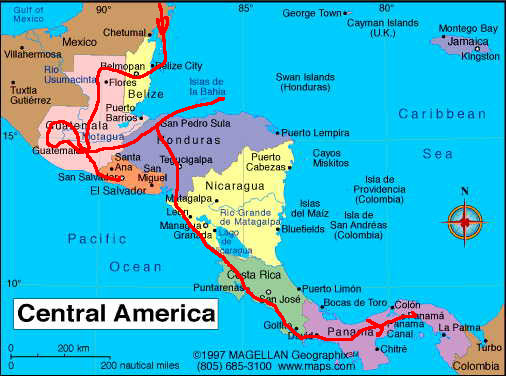
Attention Russian readers: Take a look at the links,http://groups.yahoo.com/group/alextravel/links now available in Russian.
My next trip will be to Central America. I will start Jan 7 2004 from Cancun, Mexico; proceed through Belize, Guatemala, Honduras, El Salvador, Nicaragua, Costa Rica and return from Panama in April 2004. I found again, that tour books are not very useful for the understanding of what really to expect there. The tour-books impose on themselves so much censorship... They do not want to harm any minority or indigenous people; they want to be politically correct and environmentally friendly. With all these limitations lots of useful information gets watered down. From all the sources of information I studied, I found that the most useful one is the Internet site of Russian hitchhikers: http://www.avp.travel.ru/ Their chronicles are written by international bums for international bums, without any concern for political correctness and stuff like that. Some stories are amazingly adventurous and pretty well written. I would recommend you to read the story of a hitchhiking trip across Africa, by Gregory Lapshin http://www.africa.travel.ru/Gril.htm and stories written by Vladimir Dinets. http://dinets.travel.ru/ Most of them are in Russian, however.
Back to my trip, I will skip Cancun with all its all-inclusive super hotels. I plan to investigate the Atlantic coast south of Tulum in Mexico. It's waterfront cabanas are world famous among backpackers. Then I will cross the border from Mexico to Belize by boat from Xcalak to Ambergis Caye and visit the largest atoll in the Northern hemisphere located nearby.
The rest of my trip is not clear yet. In Guatemala I will visit Tikal and Lago de Atitlan, in Honduras - Copan and the Bay Islands, in Costa Rica - national parks and in Panama - the Panama canal. Another possibility is to fly to Panama first and start from there. Anybody who has any suggestions or recommendations please let me know.
Also, I never paid too much attention to immunization and health issues. But it looks like in Central America I have to. Books recommend half a dozen different immunizations and do not indicate which are really needed, and which are not. Also, about malaria, do I have to take malaria drugs? and what kind? Does anybody know anything about it?
My main means of transportation will be as usual the folding bicycle, which I fixed by welding broken frame and handle bar stem.
Map of my trip

Alex Mumzhiu
Washington USA
Nov 30 2003
Hello my dear readers,
Happy New Year!
I would like to thank you for many letters of advice on Central America. Most of advice were on medical matter and crime situation in Central America.
Let me tell you what conclusions I came up with.
I decided to not make any immunizations and do not take anti-malarial drugs in advance. If you are careful of what you eat and what you drink, the chances of getting infections are slim. As for malaria, it is better to buy antimalarial drug locally, in Costa Rica for example. Malaria has many different forms and locally they cell drags for that particular brand of malaria which is most fashionable there.
I know some people like to say: "I do not want to take any chances". This saying seems to me statistically meaningless. We always take chances, willingly or unwillingly. And these who really want to avoid the biggest chance of death or injury should immediately stop to ride cars and use showers, two most dangerous activity,... statistically .
Final influence on my decision was produced by my acquaintance, retired general who visited Central America several times with his wife and did not take any immunizations. As for malaria he says "you will barely see any mosquito in winter".
He was robbed however in Guatemala by armed bandits when he rode in the hotel's van along with others guests. Fortunately I do not stay in hotels providing transportation.
Yes, crime is another big issue. The most of Central American governments start crack down campaign on their street mafia. News media are full of terrifying reports:
"Gang members are dismembering young women bodies to sent police a message of defiance". Why do they sent messages of defiance this way? Cannot they find a better use of young women's bodies? I cannot imagine Italian mafia doing such stupid thing. I see here a deep routed Mayan tradition. But Maya prefer to throw young women in senodes (wells) to please their gods.
I visited 66 countries (see attachment) and was never robbed, mugged, harassed or something like this. I think it's all because of my way of traveling on a folding bike.
These folks who are hanging in the streets and want to rob tourists, these folks shout "good bike" and show their thumbs when they see me. It happened many times already, in favelas of Rio-De-Janeiro, slams of Valparaiso and in dark alleys of Phnom Phen. These people do not consider me a typical tourist, who is legitimate target for attack. An adult man on children's bicycle looks very funny to them, and they are happy to see this little circus coming through their poor neighborhood.
This little circus gives them a chance to have a break in their tough business of robbing foreign tourists. Also even the meanest of them realize that there is no other such bike in their neighborhood. So if this bike will be stolen it will be easily located by police
Also, every tourist in Middle Eastern or SE Asian countries is surrounded by crowd of beggars, helpers, hustlers, merchants, peddlers you name it. When you are on bike you are immune to them.
It is amazing that in spite of such heavy propaganda I have not seen any person so far to follow my example of traveling on folding bicycle.
This time I plan to camp few times and my backpack is a little bit more heavy then I wish- 8 kg (19 lb) In addition to minimal set of clothes I carry, sleeping mat, cocoon (instead of sleeping bag), tent, mask, snorkel, bicycle parts and tools and lots of books and maps.
Most up-to-date information I found, however, at Lonely Planet bulletin board http://thorntree.lonelyplanet.com/
Alex Mumzhiu
Washington USA
Jan 6 2004
PS: The most traveled man in history, according to Guinness book of records is Heinz Stucke. He traveled non-stop for 40 years
See his story at from http://www.bikechina.com/heinzstucke1z.html to http://www.bikechina.com/heinzstucke5z.htmlThe bus from the airport to downtown Cancun was driven through Zone Turistica where most of the mega hotels are located. I got an impression that average middle class Americans (and some lower-middle class ones) can afford to come here to be treated as royals. Some people enjoy that treatment immensely and want to have it again and again. I tried it a couple times. It was nice, but I do not have the feeling that I want to experience it again and again. Different people have different priorities. Think about mountain climbers. For the money they spend on exhausting climbing in Himalayas, they may have dozens of all inclusive resorts.
Cancun stinks. It is a tourist trap with the unhidden intention to pull as much money from you as they can. Prices are American or higher. I stayed in the only decent place, I found here. I stay in a hostel, in 6 bed dorm, for $9 per night. It has a typical hostel atmosphere with friendly personnel and a bunch of nice young people around. It is a both sexes dorm. So there are a couple nice girls in next bank-bed. Isn't it an interesting alternative to Sheraton/Marriott?
Another good finding is specially for Russians. Mexico is a tequila only country. But I do not like tequila. I found 40% sugar cane alcohol called cachorro. It is sold in 400 ml bottles with a piece of sugar cane inside. It tastes pretty good and cost 10 pesos(90 cents). You can pour it in a bottle from mineral water and take to a restaurant to drink it instead of that ugly tequila.
One doctor told me that in my age people consume one of two, a lot of medications or lot of alcohol." I do not take any medication, so far...
People in American look down on Mexicans and other Latinos who come to America to do most unpleasant and lower paid jobs. And Americans think that all people of these countries are like them. It is not true. Here, and in my previous trips to Mexico city I saw people in the streets who look quite different: They are tall, with proud faces, they look like the direct ancestors of conquistadors. These people do not sneak to America in cattle cars. Those who come to America are poor, not educated peasants who escaped poverty and hunger. And we have 35 millions of them by now. They are even unable to learn English, but usually have large families with many children. Is is interesting, it is an intentional or un-intentional result of American emigration policy?
Ocean shore between Cancun and Tulum is filled with lots of tourist attractions reminding me scaled down and poor version of American Disney world. Most of them have names starting from X like Xcaret, Xelha, Xcalak. They are ugly. I also wrote to you before about seaside cabanas recommended by Lonely Planet. Maybe they were good in the past, but now it is miles after miles of beach sidehouses standing shoulder to shoulder and price of stay in them are pretty high.
However not everything is so bad. I found here an amazing hidden campground, 25 pesos per day. It is located in a pretty bay under the shade of palm trees. In addition to the ocean it has two senotes in very close proximity, 100 ft. Senotes are salt or fresh water lakes with a limestone bottom and shores. Water in them is crystal clear and quiet, no waves at all, and they are full of fish, multicolor tropical fish.
A reef is located about 400m from the shore in the middle of bay. The reef extends from one end of the bay to the other. So if you go to the end of the bay you can practically walk to the reef. Reef is shallow about 10 to 15 ft. deep. It is not fantastic, but decent one with different reef formation and fish. For first time I see a reef to which you can walk from the shore. It is very convenient and pleasant.
It is impossible to find this campground without a tip, because in order to get there you have to go through an upscale restaurant, actually you have to walk between tables.
The restaurant serves tour bus tourists and is empty most of the time. There are no
usual campground facilities, like tables and shower here. But campers can use the
restaurant toilet (very clean) and electricity. The restaurant owner advertised it
probably in order to attract more customers to his restaurant. But patrons of the upscale
restaurants and campers are different spices. This is why when I came, I found only two
tents; a retired American lady and twoyoung Mexican guys. Every evening we have a fire and
drink vodka with tortias and salsa from the restaurant. They gave us a huge
bag almost for free. Probably by the end of the day they have to throw them away anyhow.
Senotes are surrounded by mangrove forests and in addition to tropical fish they are inhabited by many birds, a couple of them, very big ones, of unknown type to me. I never saw any other person at these senotes.
I start my morning with swimming in senotes. Then I open a couple of coconuts and drink coconut milk. I learn to distinguish which coconuts are better. Fresh and green have almost tasteless coconut milk. But older and yellowish ones have sweet and very testy milk. Next I go to reef and collect second part of my breakfast. It is sea urchins, yes it is right! These who read my reports from trip from Tunisia to Russia may remember that while I was in Southern Italy I notice that sea urchins is pretty common snack there. This is there I learned how to eat them.
I usually collect entire bag of them. I hit the bag with urchins gently to break needles. Than I break urchin with stone and remove eggs with plastic spoon. Spoon also provided by the ocean. The urchins eggs have very mild delicate tasty. Not surprisingly sushi with sea urchin eggs, called "uni", I believe, are most expensive sushi. From now sea urchin eggs is my favorite seafood
Well, it is such a Robinson Crusoe life. This campground is much better than these Tulums cabans, which have a piece of sand beach in front of them and a view of nearby houses. And they do not have senotes or reefs nearby.
This place, which I found is so good that I even do not risk to publish precise directions, but I will give it on request to any of you, my dear readers. For now I will just tell you that it is in Tulum neighborhood.
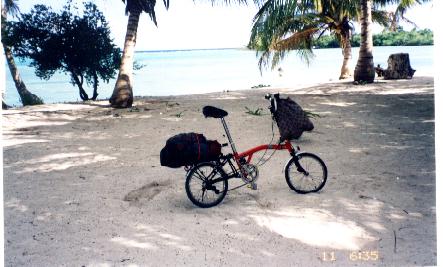
1. This is how I travel. I carry most of my load on rear pannier, but also some of my stuff on handle bar. I bought front pannier, but I prefer to hang a bag with fins, mask, snorkel and other bulky stuff on the handle bar in the bag.
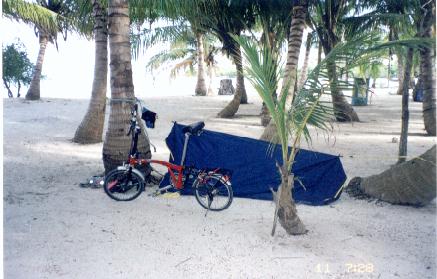
2. View in campground with my tent and bike.
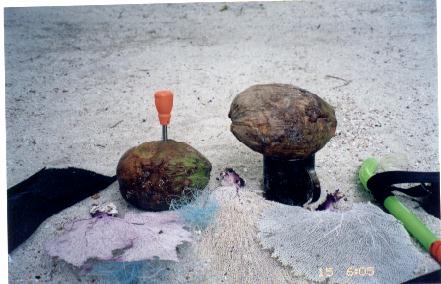
3. This is how I get coconut milk, with screwdriver
Alex Mumzhiu
Playa De Carmel
Mexico
Jan 15 2004 7pm
My dear readers,
Thank you for your responses. Sasha A from Washington asked: "Are they, sea urchins,
are easy to identifyA?" Yes they are. See attached picture.
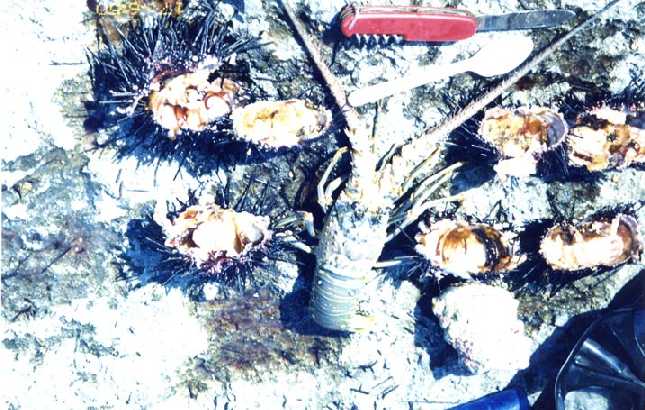
1. Sea urchins with langustino, which I caught with bare hands
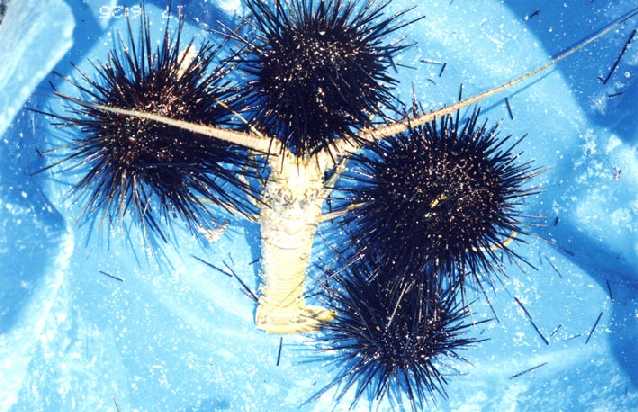
2. Sea urchins cut in halves to remove eggs
Alex
Hello my dear readers,
1. I decided to publish the precise location of that very good campground, of which I wrote you before. It is on road 307, from Cancun to Tulum, 8km before Tulum. You will see a sign "Oscar Y Lalo Restaurant" and a small road, heading towards the ocean beginning under this sign. In about 1 km the road reaches the restaurant. As I said you have to walk between tables to the beach and campground area. Cost is $2.00 per person and additional $2.00 if you want to use electricity. The owner (Oscar) provides extension cords but lamps or electrical stoves, you are supposed to have your own. Those who are not comfortable with a tent can find some cabanas about half a kilometer down South along the ocean. Price is about $50 per day, but some of cabanas are pretty good.
2. The discussion about sea urchins continues... A reader from NY, Misha M. sent me a letter of concern about possible reduction in the population of sea urchins as a result of my hunting on them. His letter is in attachment. Dear Mischa, Do not worry. The population of sea urchins exceeds the human population many times. And your concern about their well being is the same as would be someone's concern about the population of Siberian mosquitoes.
3. I did some cave diving in the famous Yucatan senotes. It was great. You can see pictures in attachments You also can see the picture of a big crab there. I caught it in the ocean (sorry Misha). I caught it with bare hands and I am glad that it did not catch me. He could easily cut off my finger with his huge claws.
4. My plans eventually finalized. I will go from Mexico to Panama and back by ground transportation: bus/bike combination. Initially I planned to fly to Panama in order do not repeat my way two times. However, the interesting places are located on both Pacific and Caribbean shores, so now I will be able to see both shores. Tomorrow I will take bus to Belize border and cross to Belize. From Belize I will go to Guatemala to see Tical, than to Honduras to scuba dive at Roatan island. Than, continue toward Panama. If I get decent map I will sent you drawing.
Alex Mumzhiu
Playa De Carmel
Mexico
Feb 9 2004 9 pm
Attachment:
Letter from Misha M.
Hello Alex, I am back from my trip to Hawaii and finally have some free Internet time to answer old emails. Your story about sea urchins makes me concerned that by the time I get to the mexican pardise you describe, the urchins will be gone. Their entire population will be totally destroyed by a single man - Alex Mumzhiu! :) You see with the current trends of human population growing and every other species of wildlife declining - there are already less urchins in the world than humans. I am neither a biologist nor an ecologist and I don't know what role urchins play in the food chain, nor how many could be safely taken without changing the eco-balance, nor how long it takes to replace those you ate... But I think we, as humans, can no longer afford to eat food that wasn't specifically grown or raised for our consumption (sea-urchin farms?) I am not particualrly law abiding, but I do respect the laws that "make sense" I.e. many countries, from US to Thailand, have environment protection laws that make it illegal to take any part of the reef life within 1000 feet off shore. The natural world is being destroyed with alarming rate - haven't you noticed yourself that many things you've taken for granted in your youth, are no longer there? Anyway, I only wanted to ask you to leave some urchins behind - so by the time I get to Mexico, they'll be still there.
MM


My dear Readers
Here in Mexico, I met an interesting guy. His name is Alex Sveshnikov. He is a Russian emigrant who lives in Canada. He just returned from Cuba and told me a lot of interesting stories, which I would like to re-tell to you. He grew up in Leningrad and emigrated to Canada many years ago. I found his views on most topics very similar to mine. So if I visit Cuba, I probably would have the same impression. I repeat, as a law obeying US citizen I DID NOT VISIT CUBA.
So here are Canadian Alex's stories: Havana impressed him very much. It has a lot of beautiful buildings and architectural assemblies there, most of them are impressive 18th-century baroque palaces built in very lavish and luxury styles. It reminded him a little bit of the Petrogradskaia storona of his native Leningrad. The most of the buildings are in very deteriorated condition. This circumstance makes the view even more dramatic. Cars on the streets are mostly antique but usually are well restored. Such cars would cost hundreds of thousands of dollars in Canada, and of course the USA. He had an impassion that he was in a live, city-wide theater. Prices are pretty low. He stayed in casa pariciculare for $15 per night. Lobster costs $5. These beautiful old mansions which I wrote before, were nationalized and divided into small apartments, similar to Soviet style communal apartments in Russia.
He stayed in a room with an 8 meter tall ceiling. As I said he felt like he was in a theater. And local people performed the roles of actors in this theater. These prices which seem so low for tourists are astronomically high for the local people. Factory workers or pensioners make $8 per month, yes 35 cents per day!!! Long forgotten symptoms of Soviet Socialism are everywhere. Long lines in "peso" stores, infrequent and overcrowded buses, humiliating searches at store exits. And a policemen or two are seen on every corner. There are a lot of regulations and prohibitions like there were in the USSR. For example a man is allowed to change a girlfriend once in 6 months. But you can smoke everywhere. Like it used to be in the USSR, they have chains of dollar denominated stores, where more well-off Cubans can buy luxury products, not sold in ordinary "peso" stores. Ordinary Cubans do not have dollars. These luxury products, not available for pesos, include meat, chicken, cooking oil, soap, toilet paper... Well, it looks like a good illustration of the well known fact that Socialism cannot provide a decent life for its own people. However it is capable of building perfect countries for tourists.
There is virtually no crime here. As I said, police presence is enormous. Also every person have to carry ID with fingerprints. Every person is accounted by huge army of bureaucrats. Everybody is under control. This system works fine to control population. It cannot provide good productivity, however.
There are no traffic jams and not so much pollution, because there are almost no other cars except for these 60 to 70 year-old monsters (beautiful however).
The United States is wrong with its policy towards Cuba. They should keep Cuba alive as long as possible as an example of Socialism, especially for those who still think that Socialism may not be such a bad idea.
Alex said he was very sorry that he did not bring presents as Lonely Planet recommended. Because the Cubans are cut-off from the Western world, anythings brought from the outside world to Cuba are greatly valued, even such simple things as pieces of soap accurately enveloped in colorful paper and given for free in most Western hotels. It was exactly like this back in USSR. It is amazing that it does not matter where you put the seeds of Socialism, in the Siberian tundra or on a tropical island of Cuba, the resulting ugly tree of socialism will grow the same.
Like used to be in USSR, women are ready to marry anybody to escape from the "freedom island". Alex introduced me to an interesting couple which just came to Cancun. He is 61 old Norwegian man. She is stunning black lady, 20. She is much taller than him. However there is some difference in sex relations. American women do not rush to Russia to merry Russian man. The same Alex introduced me to an American lady, who came to Cuba five month ago and found fiancee. She left to do a complicated paperwork. When she came back, her fiancee is gone. He married another women and left. Incredibly, in 4 days, she found another fiancee, a velo rickshaw!
Alex Mumzhiu
Playa Del Carmel
Mexico
Feb 9 2004
11 pm
In attachments are the pictures which Alex Sveshnikov allowed me to re-sent you.
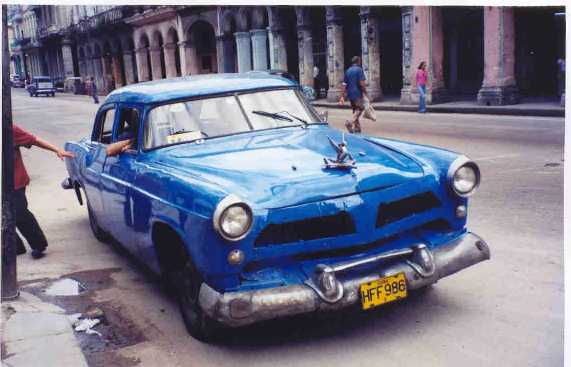
1. Old car on street of Havana

2. Women in traditional clothes
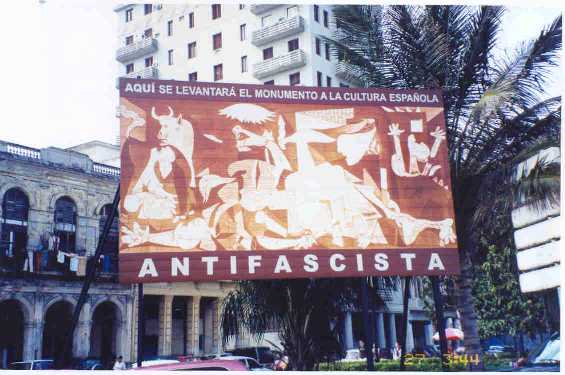
3. Street propaganda (Picasso, Gernica)
My Dear Readers,
I left Mexico eventually. I rode my bike from Playa Del Carmel to Tulum and looked for good places to camp and snorkel. Some places have pretty a nice reef, but there are so many people there. That place, about which I wrote to you before, behind the Oscar Y Lalo Restaurant is the best. I snorkeled there in the reef completely alone. Well not completely, it was one woman there also, which for some reason prefer to swim, dressed only in fins and mask.
From Tulum I took a bus to Chetumal (Mexico). From Chetumal I rode my bike across the border to Corozal (Belize). From Corozal I took a boat to San Pedro city on Ambergris Caye. This is what Lonely Planet recommend in order to avoid Belize city. Belize City is considered to be very dangerous.
Well, talking about danger, I should tell you a story. My friend NG constantly sent me warnings on different places in Central America. However, he, himself, learned on his own experience that you cannot escape from your fate. He moved out of center of the Washington DC area to the far away suburb because Washington is too dangerous. Soon he found out from the newspapers that one of the most dangerous terrorists was his next door neighbor.
So I sailed by boat to the most safe place in Belize - the Ambergris Cay, the home of expensive resorts and golf courses. Yesterday, I rode my bike to my hotel ($16 per night). My hotel is slightly out of the center of the city of San Pedro. The road to my hotel and the little plaza in the middle were full of angry black people. They shouted anti white slogans and were very agitated. It turns out that one black man was killed by police this day. It was the second such case. The previous was one a week ago. My bike has always saved me. If I walk through this crowd, it may be a different story. One man, on bike, however, went on a collision course with me, but I out maneuvered him. I came to my hotel, took some money and was ready to go through the same route to the city, to buy some food and some Belize rum. I normally try to suppress the voice of wisdom. But this time I did not. I stayed home and had modest dinner of sweet tea with old cookies. As it turned out, the riot started just about this time. Angry people overthrew cars, smashed windows, kicked several white tourists, but not me. The next morning military police were everywhere.
I took a snorkeling tour yesterday. They bring us to Hol Chan Marine Reserve. There was nice coral there, a lot of fish, and the same amount of tourists. Marine reserve is far from the shore and you cannot reach it without a the boat. Most of the diving sites however, are about a mile from the shore. Dive shop employees, tell everybody that you cannot swim to them because of the long distance and strong wind from the sea. I did it yesterday. The reef was not so spectacular as the marine reserve, but I was there alone. I found and brought to the shore two large conch shells. I broke them with a stone like prehistoric man and ate the conch meat. I know Misha M. will condemn me strongly, and he will be right. The only thing I can say in my defense, is that I was inspired by Japanese people, who invented sushi. I wanted very much to try the raw conch. It tasted very good by the way. Also I do not think that any tourist will do the same weird thing.
Yesterday I went to Captain Morgan Resort and Mata Chic Resorts, 3 and 7 miles North from the San Perdo. These resorts were the place of TV serial "Temptation Island", one for gays, the other for lesbians. I forget which is which. The price for a room is $250 per night and all are booked. I saw there a few overweight American women with artificial breasts and also overweight husbands. I was not tempted at all.
Today I snorkel to the reef from the shore again, on Ambergris Cay. I swam to the reef about 1.5 mi. When I realize that the most interesting part of reef is about 100 meters away and I have to swim there parallel the shore, across the inlet, the hole in the reef. When I swam strong current pulled me to the ocean. It was so strong, that I cannot resist it. Fortunately one of dive boats rescued me and brought back to shore.
Alex Mumzhiu
Caulker Caye, Belize
Feb 14 2004 7pm
mumzhiu@yahoo.com
http://groups.yahoo.com/group/alextravel/
PS I will sent pictures later Internet is very expensive here
My dear readers,
I would like to remind you that the address of my Internet site is: http://groups.yahoo.com/group/alextravel/ Anyone can go there and read my notes, Yahoo, however, does not store pictures. You can subscribe and receive my Travel Notes (with the pictures) to your home E-Mail address. Instructions on how to subscribe are at the above site.
Current, as well as most of my previous TN are most easily accessible at the site of North American Brompton bike dealer Channell Wasson at: http://www.foldabikes.com/CurrentEvents/Story/TravelStories.html
Continuation of travel:
I left Ambergis Cay and sailed to Calauker Cay. It is a nice little island with a population of 800 people and 10 times as much tourists. I planned to stay there for a while, but next morning I had an un-explainable urge to move. It happens with me from time to time. Fortunately I have no obligations, no reservations, no confirmations... So I took a boat and sailed to Belize city.
Tourbooks are right. You have to avoid it as the plague. A bunch of aggressive black males were sitting on sidewalks and bothering passers. I was on bike, so I was able to escape from them. Walking would be suicidal. I did not try any risky things in Belize city, but in Belmopan, the capital, I told to the annoying taxi driver "to get lost". He became furious and repeated many times that in Belize city I would have my throat slashed for such words. This is what tour book said: "It does not matter how ugly they behave, you have to be very polite with them, or things will get worse"
From Belize City I went to San Ignacio, nice, little, tourist town. I went from there on tours to see surrounding caves, waterfalls, and Mayan ruins. I also took one day tour to Tical, Guatemala. Tical is great. However in a row of compatible sites I will put it behind Angkor Watt, Cambodia and Michy Pitche, Peru. Today, I take a bus from San Ignacio to Dangriga. Dangriga is main town of people called Garifuna, assessors of black African slaves and native Caribbeans. Garifuna are best known for their vibrant music, punta dancing and knocking drums. Tour book warn however about hustlers, the same thing as in Belize city, but on much smaller scale Tomorrow I will sail by boat to Puerto Cortes, Honduras. I changed my route again. I plan to be in Costa Rica by beginning of March and start my road back home in the beginning of April See attached map
Attachment:

1. Map
2. Me
3. This is related to my previous TN. This is commercial for serial Temptation Island. As I wrote before you will not find such people there anymore
Alex Mumzhiu
Dangriga, Belize
Feb 20 2004
7 pm
GOOD NEWS FOR MY RUSSIAN READERS
Roman Zapatrin (Romanycz) translated my Notes in Russian. They are available at: http://romanycz.travel.ru/citi/mumzhiu/tn.htm
My English is a little bit handicapped, I knew that. So his translation definitely is better than my original.
Alex Mumzhiu
Utila Caye
Honduras
Feb 24 2004 7 pm
My Dear Readers,
From time to time I receive very encouraging letters from you, such as the
letter from Harold Smith, Canada, which I put in the attachment. Such letters
help me to continue to travel and to write TN. Well, I would travel anyway.
But sending
Travel Notes with the pictures is sometimes a pain. It is nice to know that my TN are
interesting not only to my friends and family, but also to many other people. Thank you
dear readers for such letters.
I visited more than 70 countries and I never have been robbed, mugged, seriously sick or injured. It is not because I am overly cautious (it doesn't work, by the way), it is because I have a hell of a lot of experience. Encouraged by that last letter, I decided to share my experience with you, my readers. I will write several TN solely devoted to traveling techniques. In next TN I will list all things which I take to trips.
HONDURAS.
"Cto-to bespokoit menia etot gondyras". "A ti ego ne cheshi". (untranslatable from Russian)
So as I told you already, I took the boat from Dangriga, Belize to Purto Cortes, Honduras, for $50, 4 hours. My neighbors on this boat were real travelers. Two guys from Canada and France and two nice girls from England. I should tell you that I get a little bit sick from vacationing American couples, which filled Ambergis Caye and San Ignacio. When we came to Puerto Cortes the taxi driver offered to take us directly to the bus to La Sieba, the final point where all of us wanted to go. I refused to go. I am already cheating a lot (compared with honest bikers) by taking buses and boats. So I unfolded my bike and started to ride from the harbor to the bus station. It was hot, dusty and the road was bad, and I thought how stupid I am. My life did not teach me anything. Exactly the same story happened to me when I was 27 and took a trip in Altay mountains in Russia. But in Altay I ended up sleeping under fallen trees in the forest infested with mosquitoes and bears instead of being surrounded by nice girls in a commercial tour trip. Suddenly a bus in front of me stopped and the driver invited me inside. It was the bus with my boat companions. I cannot resist the temptation and got into the bus. Boys along the road sold live iguanas for food. The driver was very surprised to learn that I never ate iguanas. I told him that I am from a country where polar bears are more popular food.
From La Seiba I sailed by boat to Utila Island. It is really a diver's dream: Ten dives cost $125. Hotels and food are also very cheap. I rarely have a temptation to splurge. But here I had it, and I did not resist. I rented a nice room with private bathroom from three sides surrounded by the sea, Hotel Rubi's, $13. The sea is just 1 meter from my window. So when I go snorkeling, I put fins on, in my room. Dives are really good here. Many people come here year after year. I also planned to stay here for at least a week. But I am not a person who likes to enjoy the same things. I like to exploit new things. It is in my genes. I read about it in a scientific article. Such people are called novice seekers. They have a tail of one specific chromosome (I forget which one) longer than normal people. So I cannot do anything with this. I took six dives and tomorrow I am leaving Utila. While snorkeling on my own I caught very big langustino (lobster). I will sent picture later. It is amazing but in all Latin America, they do not know how to prepare lobsters. They grill them. Lobster should be boiled.
Alex Mumzhiu
Utila Caye, Honduras
Feb 26 2004
PS: I forgot to tell you that Belize is a very English influenced country. They respect tea very much, unlike their Latino neighbors. The best tea in my life I drank in Belize. It is called Lychee tea and manufacture by Dilmah tea company from Ceylon. I never saw it in America.
Attachment the letter from my reader Harold Smith.
Dear Mr. Alex Mumzhui:
I would like to thank you for all the wonderful Travel Notes you wrote for your readers over the past few years, and to express my sincere hope that the unexpected health challenge you encountered in September 2002 has been fully and decisively expunged.
I discovered your Notes about a year ago and have been reading them from the USA Brompton cycle distributor's site and then later from the more complete master site at http://www.poxod.com/hotline/bike.htm
The Notes were a tremendously good read and provided me with a huge amount of vicarious enjoyment as I belatedly followed you on your adventures around the globe - you with your trusty red Brompton and small backpack, and me at my computer (and with my own new Brompton and assorted LP guides waiting restlessly in the next room).
You certainly know how to write engaging tales - they reflect your obvious ability to relish life to the fullest and share that enjoyment with the people around you, both those on-site and by correspondence.
I deliberately spread the reading of them out over several weeks so that I would have something to look forward to after a hard day's work. It was good.
I sincerely hope you have now been returned to good health and full function, and that you are planning additional expeditions.
Unless I am very mistaken, you have many many readers who are anticipating sharing your next adventure; I certainly am one.
We look forward to your next Travel Notes, or at least some "news from Alex" to bring us up to date.
Yours truly,
Harold Smith, Canada
As I promised, I sent you my first note on traveling technique, which list all the items I take to a trip. Next one will be on money management, and another one will be on food/water safety.
Traveling light is the key to happy traveling. Your luggage should weight not more than 5-8 kg. With such weight you can go sightseeing and do not have to rush to hotel to leave your luggage. It also have to contain all items you will need. Some of them will be difficult to buy on the road. If you are on a long trip you cannot take enough clothes for the entire trip. So you have to wash your clothes. Take a minimal amount of clothes and wash it more frequently. What most backpacker carry in their huge backpacks is dirty and un-used clothes.
Backpack:
It should be made from clothe, not from one of these man made materials. It should have several pockets outside and a couple of compartments inside. An expandable pocket on the bottom is very useful. But I cannot find such backpacks recently. I put small items in 3-4 separate bags made from mesh (setka) material in order not to have mess in my backpack.
List of items I take on trips:
Alex Mumzhiu
La Fortuna
Costa Rica
March 9. 2004
10 pm
Hello my dear readers,
In the past five years, while I travel extensively, I have visited most of the places which "I wanted to visit for all my life". Fortunately I found more places I wanted to visit, mostly from reading other travelers' stories. One of my favorite is Vladimir Dinets. In Central America I follow his footsteps. See "America Latina" at his Internet site: http://dinets.travel.ru/
After you reed Dinets's stories you are eager to visit places he visited and described. It is exactly opposite to what I feel when I read my tour-book. This time I took "Let Us Go". The "Lonely Planet" tour-book for Central America is four years old and therefore is obsolete. While "Let Us Go" is more or less accurate in describing hotels, transportations, boarder crossings and other useful stuff, their false, enthusiastic style is very irritating:
"Go, go party, rub shoulders with locals (Garifunas for example)" they invite you. In conclusion however, they do not forget to advise you, to go in large groups and to take a taxi on your way home. So following the Vladimir Dinets, I went to Santa Rosa National park right after entering Costa Rica from the Nicaragua.
The major difference between the two of us is the following:
Vladimir traveled with his girl friend, but I travel with my bike. The bike has certain advantages and disadvantages compare with a girlfriend. The bike makes me more mobile. But while I love my bike, I cannot make love to it.
So from the border I rode the bike to the entrance of Santa Rosa park. I was not so lucky as Vladimir with hitchhiking and had to ride the bike down to the bay on a terrible and steep road, made from pretty large loose stones. The Brompton amazingly survived this very rough test. The bay which Vladimir visited is closed for tourists now and I went to another bay, which is described by the tourbook as the best bay for the surfers. The best bay for surfers is the worst place for everybody else. There is a huge sand beach and crushing waves. There is absolutely nothing to do there, if you are not a surfer. There was also no drinking water or food there.
I met there a man who came there just because of this reason. He came to lose weight. He wrote a book "I lost over 30 lbs and quit smoking in 35 days" His Internet site is: http://www.bitemeproductions.com/
I spent the night in my tent and the next day I wanted to find a hitch back to the PanAmericana Hwy like Dinets did. No way, I had to push my bike all 12 km uphill on that terrible road. It was baking sun and no shade. It was a good lesson for me to learn. I plan to follow Dinets's footsteps in China this summer. But now I will keep in mind that I may be not so lucky as him. Cars on PanAmericana do not stop for hitchhikers. So I rode my bike till dusk and then set up the tent in bushes near the road. The next day I eventually reached Montoverde National Tropical Cloud Forest Reserve.
FYI (For your information): A Tropical Cloud Forest is different then Tropical Rain Forest. A Tropical Rain Forest, such as the Amazon Jungle, receives most of its moisture from the rain. The cloud forest receive it from the clouds and mist. Monteverde is an amazing place. Many consider it to be a Costa Rica's major attractions. I do not understand why Vladimir did not visit it. Sun and rain switch very often here. Actually the droplets of moisture are always in the air, even when the sun is shining. This has produced the highest biodiversity on the earth. It means that the cloud forest have more different plants per squire mile than any other forest on the Earth. It is real biodiversity madness. Most of plants do not touch the ground. They sit on the branches of large trees and get all they need from the air.
Costa Ricans deserve credit for making their Cloud Forest relatively easily available for tourists to see, without significantly damaging it. From the town of Santa Elena you can take one hour public bus to Monte Verde park headquarters. In two days I took two tours; one on a walking path, another through a series of bridges built over the deep ravines in forest. I did not take that popular zip-wire tour. As a muntain climber I did not want to participate in that kindergardner's activity. From walking path I tried several times to stray into the forest. This forest is un-penetrable, without a machete. I climbed on fallen trees and walked on their trunks inside this amazing green madness as far as I could. As for animals, I saw with help of a guide only a monkey and quetzal on the guided tour, which I took on the second day. Quetzal is a bird very respected by all Latin Americans for its beauty and spousal fidelity.
From Santa Elena I went to the city of La Fortuna to see working volcano Areanal. Again I was not as lucky as Dinets, it was rainy and cloudy and the volcano was not visible. From La Fortuna I took a bus to San Jose, the capitol of Costa Rica. I am staying here in "Tranquilo" backpacker's hostel for $11 per night and wait until my toothache disappears. I got it several days ago. Local dentist is eager to do my root canal for $150, even though it is not 100% clear that it is a root canal problem. All dentists are the same. It seems that home medicine (mumie) is improving the situation little by little. Next I will go to Panama.
Few little notes on San Jose: Costa Ricans, they call themselves "ticas" are very proud of themselves and believe that they are the "different". They really are: San Jose is the only capitol in the world where the homes do not have numbers. Address (officially) are given like this: "From Mc-Donalds take three blocks North then 2 block East, Right in front of bakery."
Their ATM machine are also quite different. Machine gave me money, than receipt and I go. When I return in an hour I learned that after giving you money and receipt, machine keep your card quietly until you answer couple questions printed on the screen: "Do you want another transaction" and so on. Fortunately nobody came after me. So after a while machine eat my card. It take pretty long time to get it out from bank headquarter. I also visited theater here, using the same technique as in St. Petersburg. I ride bike to theater, put in in bag and give to coat-room attendant.
Alex Mumzhiu
San Jose Costa Rica
Mar 15 2004 11:30am
Attachments:
1. Monument of unknown Sandinista, or Contra, I am not sure
2. Tiny tree frog from Monteverde forest, called Gaudy frog

3. Gigantic fern tree in Monteverde park
PS:
I forget to tell you how I got to Costa Rica. It was two long bus rides. First from La Seiba, on Caribbean shore of Honduras, to Tegucigalpa, the capitol of Honduras. Second from Tegucigalpa to Managua, capitol of Nicaragua.
Both capitols did not impress me. A lot was said about crime there. I rode bike in both cities after dark without problems, but walking there would be uncomfortable. Before going to Costa Rica I also visited Masaya volcano as Dinets did, Ometepe island on Nicaragua lake, and a nice Nicaraguan city, Granada.
MANEY MANAGEMENT
I misspelled the word money in order to cheat the junk mail filters. Otherwise my note will be sent to bulk mail folders, or just thrown away.
The most frequently asked question which my readers asked me is this: "How can you afford to travel for so long?"
This note is devoted solely to money management and it consists of three parts:
HOW MUCH MONEY YOU NEED.
Different people travel on different budgets. Russian hitch-hikers travel without money at all. See their very interesting Internet site:
A Canadian guy who travels on bike around the world for 3 years spends $10 per day. See his site at: http://www.jibi.ca/
One nice new Russian whom I met, spent every day $3000. Very good article on backpacker travel with serious budget consideration was published by Steve Hendrix in the Washington Post, Dec 27 1998. After serious study, the author of this article came to the conclusion that most of the long term travelers spend about $1000 per month, and the airfare is included in this amount. This is what I spend on average too.
I know that half of my readers will exclaim: "How is it possible to live on such miserable money, which is poverty level in USA."
Other half of my readers will say: "You don't have to be a rocket scientist to travel on such a huge amount of money"
Anyhow, this is what my budget is. When I travel I do not constantly think about saving money. I live a normal life; eat what I want, do what I want. If I want to do a bungy jump or skydive, I know that I can afford it within my budget.
I analyzed my spending and came up with the conclusion that there are five major factors which contribute mostly to money saving. These factors are outlined below:
WHERE TO GET MONEY FROM
Answer is: from the ATM machine. I think the travelers check and other security instruments are not worth the trouble now when you can find ATM machines practically anywhere in the world. Visa is more widely accepted than Master Card. It is better to get money from checking accounts then from credit card because the credit card will charge you for cash withdrawal and will charge you high interest for cash advance. I carry one check card and one credit card for safety.
Nowadays you do not need to take all the money you need with you. In every country you visit, you will take local currency from ATM machines. However you always have to have a few hundred American dollars in different denominations.
First, you still sometimes may got in place without ATM machine, or machine may be out of order, or out of money.
Second, many services quoted in dollars. If you will pay them in local currency, these to whom you pay, will use preferable to them exchange rate. It is for sure. So, it is better to make payments in that currency in which payment is quoted.
Third, when you approach the borders, you never know exactly how much money you will need. If you get more local currency than you need, it will give you a headache after the boarder crossing. Therefore it is always better to have some dollars, in case you get short on local currency.
WHERE TO KEEP MONEY
When I stay in reliable hostel I leave everything in the hostel. If I do not expect to be separated from my backpack during travel I carry everything in my backpack. My backpack is so small that I can take it inside the bus and use it as pillow in long ride, or as a sort of portable table for reading or writing.
I carry important stuff on me only if I expect to be separated from my backpack, like while traveling in train.
These pouches which tourists wear across their bellies clearly indicate to thieves exactly where the money is. Therefore I do not use these poaches. I have a zipped pocket inside the pocket in which I carry passport, two credit cards and few dollar bills of large denominations. Rest of stuff I leave in backpack and hope for the best. So far nothing has happened
Few more words on money matters. If somebody will built chair lift to the top of Everest mountain and erect luxury hotel there, than Everest definitely will loose part of its attractiveness. Under the same token, any place to which you can get easily, without problems is loosing part of its attraction for you. Nowadays, if you have a lot of money, you can get easily and comfortably to any place on the planet including both poles. A knew few pretty well-off people who lost interest in travel just because of this reason
In this sense, do not have too much money is even better. As I come out of airports, I usually ride my bike to the city. And this is the most exiting moment: the discovery of unfamiliar surroundings of a new country and a new city on my own. If these $20-50, which taxi costs meant absolutely nothing to me, I probably would take a taxi. It looks kind of stupid to ride a bike, not knowing exactly where, under the baking sun or pouring rain.
This is exactly opposite of what "tourists" do. They take a taxi to an in-advance reserved hotel, where they are met by their travel agency representative. It is much more civilized arrangement, but there is also much less adrenalin in such an arrangement.
Alex Mumzhiu
Boquete Panama
March 22 2004
9pm
TRAVEL NOTES FROM COSTA RICA AND PANAMA.
>From San Jose, Costa Rica I planned to go to Port Limon on the Caribbean coast of Costa Rica, and continue to the Panamanian boarder. However after reading tour books, I have both LP and "Let Us Go" for Costa Rica and Panama, I changed my plans. These tour books have to keep delicate balance between political correctness and loyalty to their readers, so you have to read them very carefully, sometimes between the lines.
This is what I read in LP "Central America on shoestrings" 3-d edition on pages 657 and 658:
"Be prudent if you enter some of the local bars(I hear occasional complaints about a local man who accuses tourists of being racist for not buying them drinks.)"
"Some single women travelers have been hassled by a few of the local men." "I also met single women travelers who had a great time." "Safe sex is rarely practiced here. If you are tempted by local sexual liaisons, bring your own condoms"
Well I am not a single woman interested in sex with different races, so I skipped this area entirely.
Bocas Del Toro, Panama is recommended as a quiet town of "friendly black people". And it is exactly like this. Even dogs are friendly there. There are a lot of dogs there. They enjoy the rights of full fledged citizens there. They live on the streets and have very active social lives there, however they behave perfectly, never bark, or bother pedestrians.
Bocas Del Toro is recommended for snorkeling and diving also. Corals do not form a reef there, they cover bottom in some areas entirely, but they are not tall, only about 0.5m tall, and they intermingled with sponges and other plants/animals. Water is very warm and full of micro organisms, some of them are stinging. Two snorkeling trips were enough for me.
From Bocas Del Toro I went to Boquete. It is full of flowers and smells with flowers. There are a lot of Hollanders there, locals and tourists. I rode a taxi, which is very cheap there, to surrounding mountains and rode the bike down to the city. You can ride a taxi almost to the top of volcano Baru, which is right above the town.
From Boquete I took bus to Panama City. Panama City is great! After traveling a while in Latin America you get sick and tired of that typical Latino Americanism. Dirty streets full of street vendors selling different junk, chaotic traffic, air pollution and so on. Panama City is different. It is a big and important port city, something like Hong Kong or Istanbul. It is pretty civilized, I would not say Westernized or Americanized, just civilized.
I attended a great show on Mariflores lock of the Panama canal. Huge oceanic ships were raised and lowered in front of us through the system of locks. Ships are paying in average $150,000 for going through the canal. I stay in hostel Voyager in center of Panama City in dorm for $8 per night.
In the middle of Panama metropolitan area they saved big chunk of jungle, 265 hectors. I rode bike there and saw more animals then in Monte Verde park including pretty funny creature called coati. I found a big construction tower crane in the middle of park for biologists to observe animal life. When I came, it was nobody around. So I ignored all warnings posted around the crane and climbed the crane. It was great. See picture in attachment. I went to the booth of the operator, walked on the arrow and remembered my friend RT, who used to work as a construction crane operator.
Next day I went on Taboga Island. Taboga is a place where the biggest pearl was found. Now it belongs to Elizabeth Taylor. When I snorkeled around I figured out why the biggest pearls were found here. Oysters here attach their bottom half of shell to the ocean floor permanently. So you cannot remove the entire oyster, only the upper shell. I saw several pretty large oyster´s bottom shells, still covered with perfect perlamuter covering. Such an additional security prolonged the oysters life, which in turn results in larger pearls
I already started my long way back home. I went by bus from Panama City to San Jose, Costa Rica. Tomorrow I will continue to Managua, Nicaragua and then to San Salvador. San Salvador is the only Central American country, which I did not visit yet. From San Salvador I will go to Guatemala where I will visit Attitlan lake and the old capital of Guatemala Antigua. Then I will go to San Cristobal de Las Casas, Mexico. I heard a lot about this city. From there I will go to Mexico City and then to Guadalajara. I do not plan to spend much time there. Then, I will go to Mazatlan, Mexico and sail to Southern tip of Baja Peninsula. I will continue from there to Northern part of peninsula to Tijuana.Then I will cross the border to San Diego, Ca, from which I will fly home in last days of on April.
Attachment:

1. Map of my return trip.
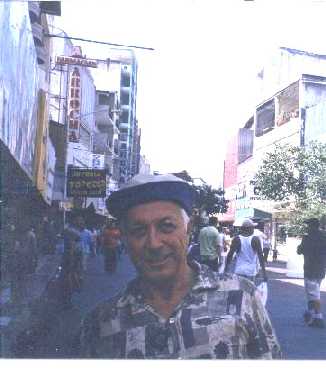
2. Alex in panama in Panama.

3. Panama City as it seen from the top of construction tower crane to which I climbed. The virgin piece of jungle below is the Panama Natural Metropolitan Park
Alex Mumzhiu
San Jose, Costa Rica
March 30 2004, midnight
I heard so many stories about food poisoning, and I know many people who were poisoned. I, myself, in my Tibet to India trip: http://www.foldabikes.com/CurrentEvents/Story/Tibet.html was poisoned three times and three times had diarrhea. It never happened anymore. I learned my lessons and made some conclusions, which I would like to share with you.
There are some clear and simple rules, such as Peace Corps rule: "Peel it, or wash it, or boil it or vom-it".
Following these rules does not always guarantee safety, because there are so many situations to which these rules does not apply. In order to avoid food and water poisoning you should have some understanding of cultural differences between your country and the country you are visiting.
The ordinary tourist, when he or she is visiting one of these crazy countries, where people eat snakes and iguanas, thinks that if he or she will stick to innocent salads and sandwiches he or she will be OK. Nothing can be further from the reality.
Eating raw vegetables is a relatively new Western invention. You do not know what fertilizers were used on these vegetables. In many countries it is human feces. You do not know what kind of water was used to wash them, if they were washed at all. For sure they did not use expensive bottled water to wash vegetables. Not surprisingly people of so called developing countries almost never eat un-cooked vegetables.
The fact that in touristy places, they sell food which tourists prefer, such as salads and sandwiches, does not mean that they prepare them right. So forget about salads. Eat what local people eat: boiled, sauteed and fried vegetables.
The same idea is related to fruits. Do not buy these ready made fruit salads. You do not know if they washed these fruits, and if they washed their hands. I always want to try these unknown exotic fruits and vegetables. However I do it safe way. I buy them, then bring them to my hotel room, wash them thoroughly and dry them, and after this peel them.
It is always better to buy them from the supermarkets. These private sellers cannot suppress their natural instincts, as they see such an innocent and un-knowledgeable buyer as you probably are. They will overcharge you, and also they will give you not a best products.
Do not buy any milk products.
Eating meat in such predominantly vegetarian countries as India is an invitation for trouble. They do not have such strict control over the meat production as in developed countries. They may not have proper equipment for the meat storage. If you cannot live without meat, be sure that your meat was well done. Don't eat cold sandwiches under any circumstances.
In places where tour-books do not recommend to drink tap water, don't drink it. Bottled water is widely available anywhere nowadays. If there is no bottled water, drink bottled beer.
Coffee and tea are also not 100% safe. In non-tea drinking countries they put tea bags in lukewarm water, which obviously was not boiled. The tour books recommend to ask them for how long did they boil the water. This is ridiculous, how do you say it in Swahili?
Your best friend is kipiatilnik (little submersible spiral for boiling water). After 10 minutes of boiling, any water will became drinkable. Systematic use of kipiatilnik is the major factor in food and water safety. If there is no electricity, boil your water on the open fire. I do not carry these propane heaters and stuff like that. You always can find a couple of dry branches to make a little fire.
If sanitary conditions get on my nerves, as it was once in Morocco, then I completely switch to kipiatilnik cooking. These Nissan Chinese cellophane soups are available everywhere. They are good and cheap and safe.
Soup is not a very respectable kind of food in the USA. But in many countries, soup is a full fledged member of the food community.
Soup is the most safe food. First of all, it has to be boiled, by definition. I like soup and I eat it a lot while I travel.
Food sold by street vendors is OK. I buy food from street vendor ladies who are neat and popular with the local people. You may call me a chauvinist pig, but I prefer do not buy food from male street vendors.
Alex Mumzhiu
Panajachel, Guatemala
Apr 5 2004, 9:30pm
My way back home looks impressive on the map, doesn't it? I did not receive many readers responses recently, but I think it is impressive. It was 4 day long bus rides from Panama to Guatemala
This is a detailed report on that trip:
I do not mind long bus rides. I make myself as comfortable as possible. I read, sleep, think. The main contradiction is this: You are supposed to not eat or drink on long bus rides. On the other hand, the alcohol drinking is the best sleeping pills. I still did not find a resolution yet. For really demanding long rides however, I do not eat or drink.
All tour books recommend to skip El Salvador. I did not do it only because one of my readers Teresa T. from Michigan, strongly recommend me to visit El Salvador. I spent one day in San Salvador and visit the so called American Pompey, the place which was buried by volcanic ashes, like Italian Pompey. Well, it was not as impressive as Italian Pompey. Also it was in the middle of work and was not ready for demonstration.
Guatemala City was condemned by all tour books as a very dangerous and crime ridden city. I spent 4 hours in Guatemala City between buses and I have a different opinion. It is probably dangerous, but it is not related to me, due to my way of traveling. But it is very interesting city. I saw a demonstration there. It looked very scary. See the picture in the attachment. They wear masks and KKK looking clan hoods, but it was a student demonstration at the local university. I also saw a beautiful buildings, which any city would be proud of. See it in attachment.
From Guatemala City I went to Antigua. Antigua has a lot of tourists, but it is still nice. When I came to Antigua it was the beginning of Samana Santa (Holy week). Entire huge central plaza was filled with people in purple, wearing Bedouin headset. A huge procession carried platforms of Christ and the virgin Mary. The entire plaza was filled with clouds of incense and it was appropriate music there. Many people came to Antigua especially for this event. Price of a hotel room jumped three times for this week, in my hostel from $2.5 to $7.5
From Antigua I went to Panachanchel on Attitlan lake. It is such a contrast to mellow Antigua. The city is very hectic, filled with endless markets, full of cars, smog and... surprisingly tourists. Only in my last day, when a fog above the lake is gone, I realized why the tourists still coming there. The lake is really beautifully. It is relatively small and surrounded by huge volcanoes.
Attachments:

1. Demonstrates at Guatemala City

2. Central post office at Guatemala City

3. Copan Maya temple, reconstruction
Alex Mumzhiu
San Cristobol De Las Casas, Mexico
Apr 8 2004 10:30pm
From Panachancel on Attitlan lake, Guatemala I went to San Cristobol De Las Casas, Mexico on a series of chicken buses. They are called chicken buses because people carry on them domesticated animals, mostly chickens. These buses are usually overcrowded. Local Indians are small and usually three of them fit in normally two person bus seats. Seats in the first row have a little bit more space. In my bus it was seven people on that normally two person front seat. It was three adults and four children. In addition, there was a turkey and a cat there. Tour companies offer ridiculously expensive tourist buses to San Christobol, but chicken buses are necessary part of Guatemalan experience. Those who have not ridden them has not visited Guatemala.
San Christobol is a nice town, which used to be a backpacker's haven. Now it is mostly ordinary American tourists there, not backpackers. I guess,with antiamericanism growing elsewhere, Americans, who still like to travel, turned to old friend Mexico.
From San Cristobol I went on a day tour to Palenque, which, in my opinion is the best of Mayan ruins. Right from the tour bus I jump to a regular inter city bus and started my long way North to the USA.
Next stop was Oaxaca, Mexico, pretty nice colonial town, with many American tourists again. But Oaxaca the main attraction, at least for me, was the following: In the nearby village El Tule they have the biggest and the oldest tree on the earth. It is 42 meters tall and 58 meters around. It is 2000 to 3000 years old. It is biggest single piece of biomass on the planet. Tree is really great, see pictures in attachment. I even put two, one is mine with necessary bike in front, another is post card.
From Oaxaca I went to Puerte Escondido. Spanish language is a such pompous (pompeznii) language. Puerto Escondido means only the hidden port, nothing more. It is nothing there except for intense heat and serf boarders. It was hot even during the night, so I did not put mosquito net, which reduce air ventilation from the fan. In the middle of night I woke up because somebody was biting me. I hit it and pulled it out of my leg. It was not a mosquito, but a much larger insect.
Because there was nothing to do in Puerto Escondido I took 5 am second class bus to Acapulco. As an experienced bus rider I took seat in last rear row and happily sleep laying flat for the first 3 hours.
I heard so many condemnations on Acapulco. Lonely Planet with its backpacker's snobizm even did not include it in the list of Mexico's main attractions. But it is great town. It reminded me Rio De Janeiro. It is also located on the nice bay, like Rio. Bay is not so picturesque as at Rio, but it is absolutely clean. In Rio, the bay is full of garbage. You cannot swim there. Here in Acapulco water is clean and people swim at the beaches located in the middle of city. I do not like these little touristy towns with chic boutique, nice little restaurants..., hate it. I was grown up in large city, and I like large cities. Acapulco is large. It is not only zona tyristica, which everywhere more or less the same. It has large old town with beautiful zocalo, great restored 16th century military fort. I like Acapulco.
I saw famous cliff divers there. Many years ago, back in the Soviet Union, my friend Oleg B. told me about his trip to Acapulco. He travel everywhere as a trainer of Soviet bicycle racing team. I never got jealous of people who have a better car, home or clothes than me. But Oleg's story about Acapulco made me very jealous. I knew for sure that I will never be able to get there. Authorities did not allow me even go to a business trip to Bulgaria. And today I was standing in front of the cliff from which divers jumped, probably on the same place from which Oleg watched it a long time ago. The show is great, they dive from 35 meters, but I think any normal person can learn how to do it. It is not so dangerous as it looks.
Alex Mumzhiu
Acapulco, Mexico
Apr 13 2004 10 pm
Attachments

1. Acapulco cliff divers
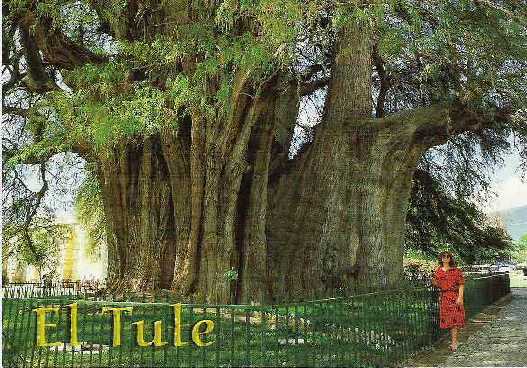
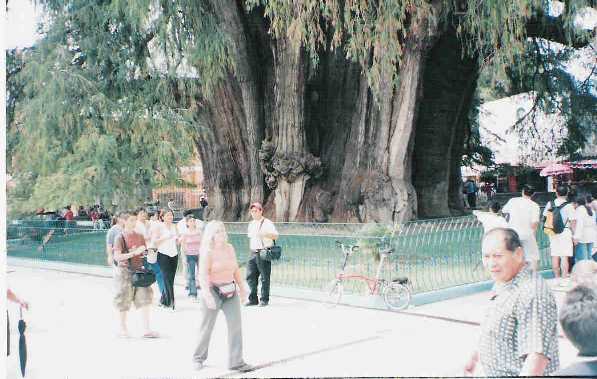
2,3 Oldest tree on Earth
Hello my dear readers, sorry for delayed TN.
I would like to say more about Acapulco. Everything I read and heard about Acapulco was
wrong "It is the worst case of massive tourism development! It is a lot of tourists
there! It is very expensive!" Maybe it is true for zona turistica but in places where
I stayed, near the zocalo in the old town, I had barely seen any other tourists.
Every Central American town has a zocalo, the central plaza with the necessary cathedral.
Acapulco zocalo is the best zocalo I have seen so far, with shady trees, a nice cathedral,
fountains and of course with restaurants and shops. The hotel where I stay was
located near the zocalo. My room was on the top floor of a four floor building, with
a good view and a private bathroom. It costs only $7. Well after midnight streets
around the zocalo are full with people and... military personnel in combat gear
and heavy guns. Nobody is alarmed by them. It looks like people do not think that the
military personnel was put there on purpose, just kind of a funny local custom...
Zona Turistica is also full of military.
Puero Valarte is a nice resort town, but it has much less character than Acapulco. The best thing about Puerto Valarte is this: In the middle of town the endless sand beaches are interrupted by a piece of rocky seashore. It is nice snorkeling there. In a couple places on the beach the vendors sell excellent oysters, $1 a piece. They look and taste like famous Belon oysters with strong slightly metallic taste. Sellers poor juice out of oysters down to the sand and then wash oysters in the bucket with murky water. I asked them not to do it with my oysters. Restaurants do not sell oysters because most tourists are Americans who prefer hamburgers and steaks.
I saw funny restaurant advertisement: A taste of Italy:
Pastas
Submarinos
Hamburguesas
Mexican idea of food is pretty funny. They cut everything in small pieces, insert it inside the tacos and cover it with fiery sauce. They have lobster tacos and oysters tacos for example. It is impossible in Mexico to get plain fried eggs. Unless you have tied the cook's hands behind his back, the cook will cut fried eggs in small pieces and mix with something else. I always was curious, if somebody cut piece of ribbon, cover it with fiery sauce and give it to Mexicans, will they be able to notice that something is wrong.
From Puerto Valarte I took the overnight bus to Los Mochis, the starting point of the famous Copper Canyon Rail Road. The bus arrived at 6 am just one hour before the train departure. Somebody may think that it is too hectic a schedule, but it was fine with me. I wisely selected a good bus seat and slept all night with help of my already mentioned sleeping pills. The best seat is the window seat in the last row. It is best because your neighbor has to sit next to the toilet door. Nobody wants that seat. So while the bus was almost full, I had two seats to sleep comfortably.
Copper Canyon Rail Road is a famous tourist attraction. It is built through the area of deep canyons. Three of them are bigger than the Grand Canyon. Scenery is great and I enjoyed it very much in spite of constant fights with conductors. That rail road may be a great engineering achievement, but it is the worst managed road I ever saw. The passengers do not have seat assignments and take any seats they want. Soon after departure the conductors starts to sort passengers in such a way that every car contain only passengers for the same destination. After this they started to compact passengers, so that the front part of car became empty and rear part have all the seats taken. I had to fight hard to re-assign me to a window seat. In the morning, when it was cold, they switched air conditioning full blast. In a midday, when it became hot, they switched it off. I moved to empty car in which air conditioning was working. Immediately my movement was noticed and several different conductors came to me and ask me to move back. But it is "frie" here and "caliente" there, I told them. Eventually they forced me to move back, but they switched air conditioning on. So my silent Mexican co-riders were also benefited by my stubbornness. Growing back in the Soviet Union gave me a taste for arguing with authorities. Most Western tourists, as I noticed, prefer to not argue with local authorities. To finish with the Rail Road I should say that on my way back, the train was delayed by 10 hours because the derailment of a freighter train in front of us. Steep slopes below the rail road are littered with rail cars. Conductors explain quietly: "This one derailed two years ago, and these two just a year ago, and these three cars just six month ago". The Rail Road is built on a narrow gage and it is still functioning, only because the American retirees love it and pay extras for first class tickets. On my way back I also took first class ticket in order to get in time for ferry to Baja California. But as I said train was late so I have to take ferry the next day.
Upper portion of the canyon county with the major city Creel is located at the
altitude of 2,600 meters. It is very nice temperature there, in spite it is located on the
Tropic of Cancer. The nature there remarkably reminds me of Karelia. There are pine trees
and stone cliffs everywhere. The floor in the forest is covered by a thick layer of
pine tree needles and is relatively flat. So it is possible to ride bike in the forest,
like I did in Karelia. It reminded me of the first orienteering competition on bikes
in Leningrad. I was the leader of my Technological Institute team. The most interesting
episode happened when we approached the finish line. We realized that we came from the
wrong side and have to cross the river to get to the finish line. The river was covered
with a thin layer of ice, so we broke the ice with bikes and crossed the river. Here too,
I discovered myself on wrong side of prolonged lake Arareco and as in old days crossed
this lake holding
bike above my head.
Canyon County is a motorcyclist's playground. I met there three American motorcyclists on huge Kawasaki bikes. Oldest of them, 77, broke his leg, but he continue biking in a cast, great man. I figured out how to go through the Copper Canyon on bicycle. But it would take at least a week, which I did not have. I rode my bike only on initial part of the way down, from Greel to El Divisadero. Even this part I did not finish, because I was afraid to miss the train. So I hitch-hiked on track carrying bulldozer and finished the last part of my route in bulldozer operators seat.
Attachments:

1. The bikes are the best transportation for the Copper Canyon.
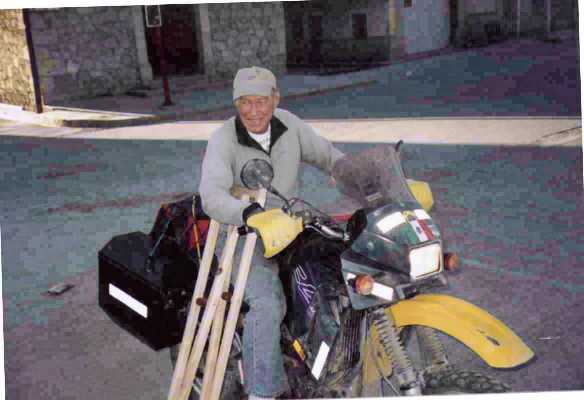
2. A 77 year old man prepare to return to USA from the Copper Canyon on his bike, in spite of his broken leg
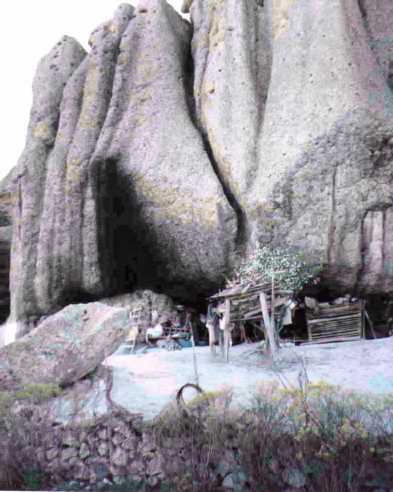
3. Tarahumara Indians, who inhabit Copper Canyon still live in caves under such cliffs

4. The result of wind erosion in Copper Canyon.
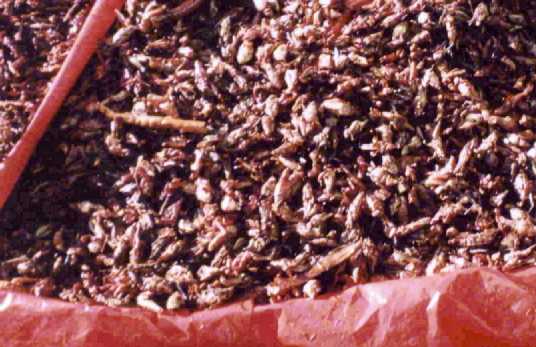
5. Mexican delicacy: fried cicadas with pepper.
Alex Mumzhiu
McLean Va USA
May 19 2004 8pm
Baja California
The southern tip of the 1000 mi long Baja California peninsula, called Land's End is an amazing place. Powerful waves carved fantastic figures from the sandstone shore cliffs with many ear like holes that are inviting for the rock climbing. Huge waves on the Pacific side (upper beach on the picture in attachment) crash on the beach with a terrible noise. Nobody was swimming there. And it came to my mind that it would not be like this if it would be in Russia. I am sure that in a place like this, there would always be a few guys (not necessary drunk) trying to cross this huge wall of boiling water.
Traveling helped me to understand Russian mentality, in comparison with others. Russians like challenges and if they see something which is difficult to climb, of something from which it is difficult to jump, they do it. I do not want to say that the people of other countries are un-adventurous, no. But they prefer to do it in more civilized way.
So as the only representative on this beach I decided to try it. I have been fighting with rough water like mountain rivers or ocean waves for all my life. It started a long time ago when my friends told me a story of the girl who fell in the mountain river and drowned, while her fellow travelers ran along the shore and tried to save here. My experience with rough water unexpectedly brought me financial success back in Russia. In Altay mountains I swam across the white water river to the almost un-inhabited territory and found there a good deposit of mumie, a valued folk medicine in Russia.
So, I swam across the crushing waves of the Pacific ocean and back a couple times, see attached picture. This unusual activity attracted the attention of a few people on the beach. They asked me how I did it. I explained to them that when you go to the ocean you have to dive under the coming waves. When you go back you have to swim as fast as possible, then, when you get in that super jacuzzi area, where the waves are crashing, you should get in fetal position and protect your head. As soon as a wave stops for a second before going back, you should run to the shore like crazy in order to not let the next wave to catch you.
I decided to swim around the Land's End from the Sea of Cortez to the Pacific side and finish on Pacific beach, which I just tested. On my way I passed a colony of sea lions, who lives on that southern tip. When I approached the beach a little crowd collected there. Everything was fine until the last moment. I did not realize that I cannot run in fins. So, I did not escape from the next wave and it pulled me back. I removed one fin and held it in one hand, in the other hand I held the mask and snorkel. And again, with one fin on my foot I could not run. So people on the beach formed a human chain and pulled me out. I was not in a bad shape and I think, if things would become really bad, I would throw away my fins and mask and run to the safety. But it was a good lesson. I did not know that fins do not help, just opposite, when you swim through the big waves to the shore.
From the city of Cabo San Lucas at the Southern tip of Baja peninsula I took a bus to La Paz, the capitol of Baja California Sur. At the scuba divining shop there, two ladies told me that the scuba season is in summer, it is too cold now. For snorkeling however they recommend I go to the small village Buenventura a few hours north of La Paz by bus. Buenoventura is located on the shore of Bahia Concepcion, a little bay on the Sea of Cortez. My bus arrived there at 3 am. It was a moonless night and I found my way to the beach with a flash light. I put my sleeping mat on the sand and fell asleep. I woke up at sunrise. I slept a little bit more and remembered that the main advantage of sleeping on the beach is that you don't have to go to the beach. You are already there. I put on my mask and snorkel and found out that the sea is full of seafood. I brought to the shore a couple of large conches, several sea urchins and different clams and had sushi type breakfast. During the entire morning I did not see anybody there. However it was a restaurant and hotel near the road, both empty.
I unfolded my bike and start to ride to the next town, Mulege. As I learned later this is the only part of Baja peninsula which is completely undeveloped. Road went through craggy, moonscape like landscape of sun baked rocks and cactus trees. It was no indication of human presence except for a few cars which fell from the road and were rusting where they fell. It was very little traffic there. By the late afternoon I got tired and took a rest in the tiny cactus's shade. Immediately hundreds of needles stuck my back. I am still removing them. I came to the town of Muleje by the evening. Next morning I took bus to Tijuana. From the bus window I was able to observe the Baja landscape all the way to the US border. The best part of Baja is South of Mulege along Concepcion bay. Some of my readers argued me not to tell everybody about good places which I discovered, but I still do it, I do not know why. If somebody will go there and find out that it is really good place, please send me a thank you letter.
THE END
Attachments:
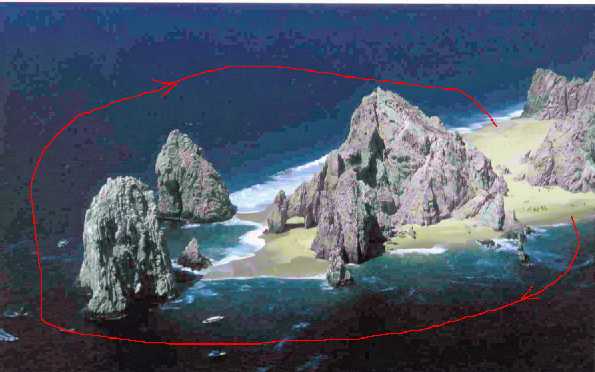
1. Land's End
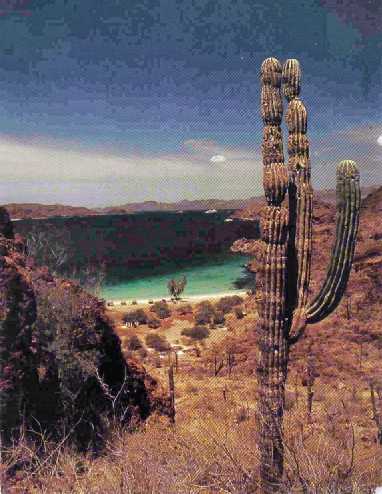
2. Baja California
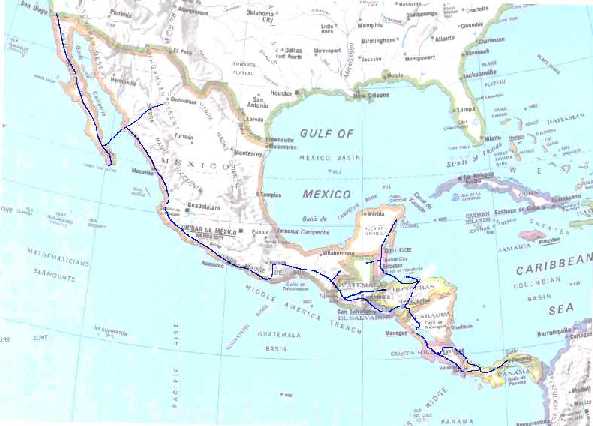
3. Map of my route. It was about 10,000 km long and it took 105 days.
Alex Mumzhiu
McLean Va USA
May 20 2004 3pm